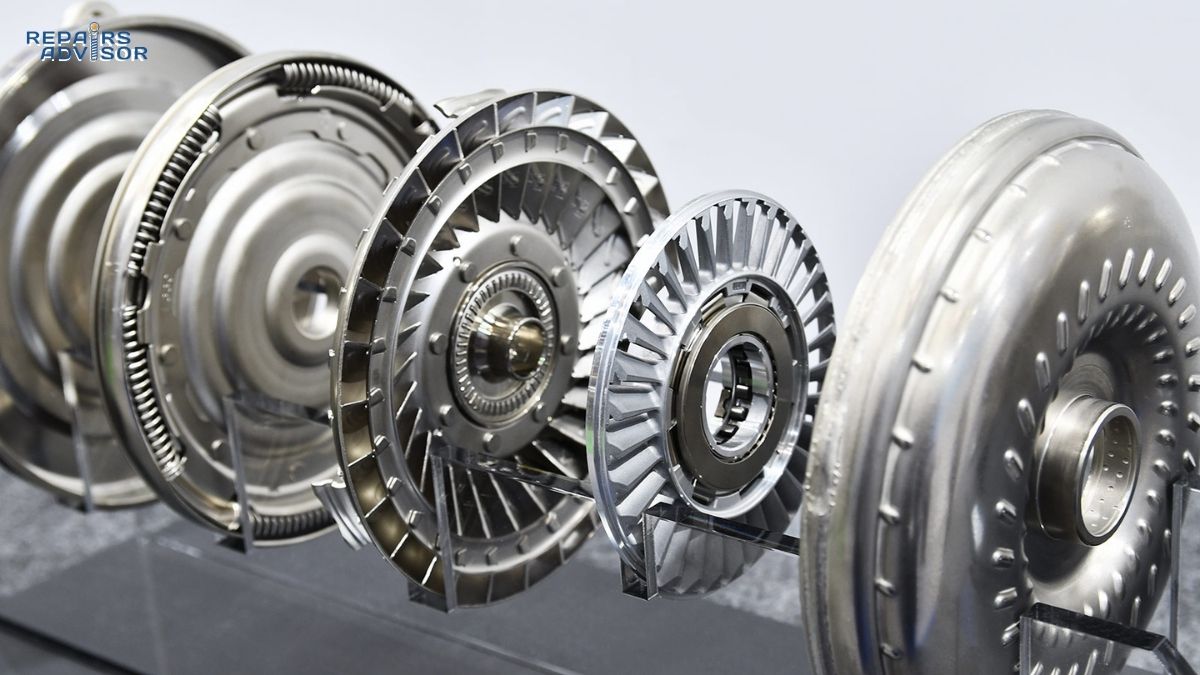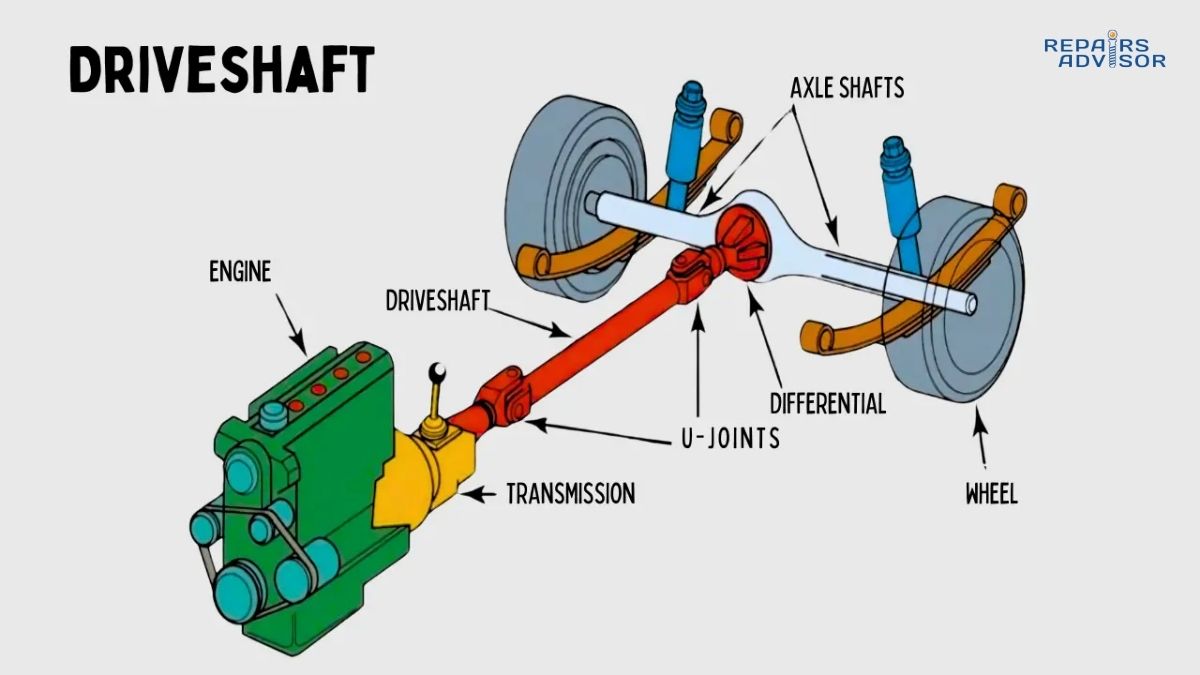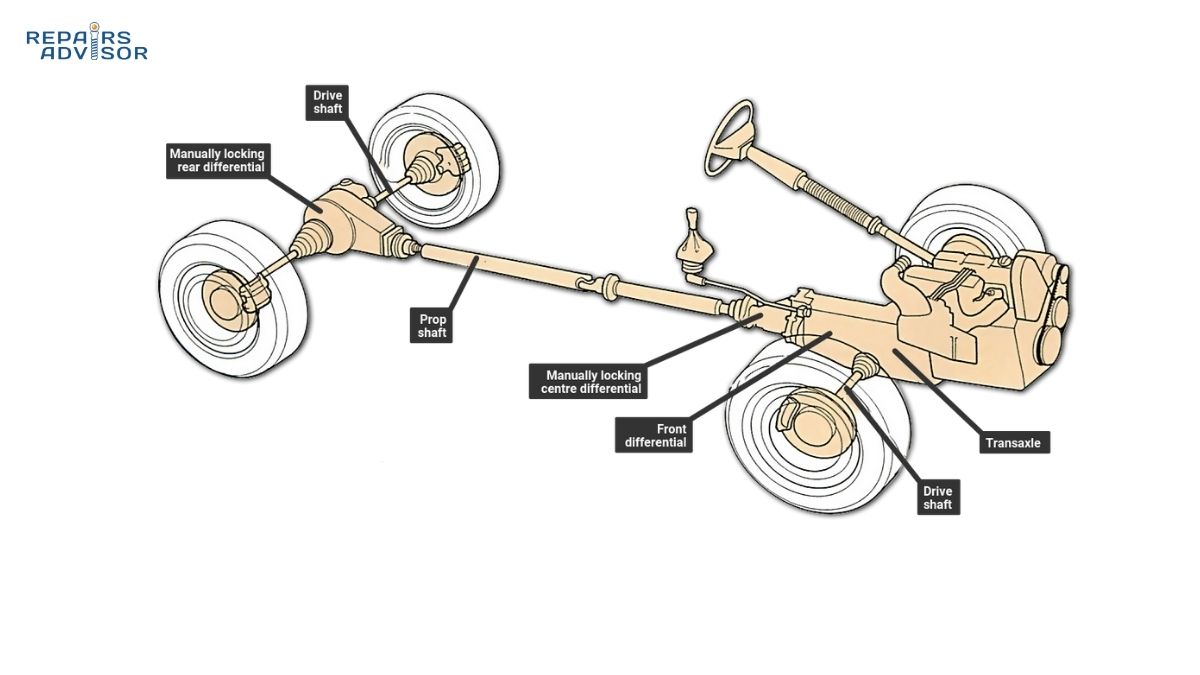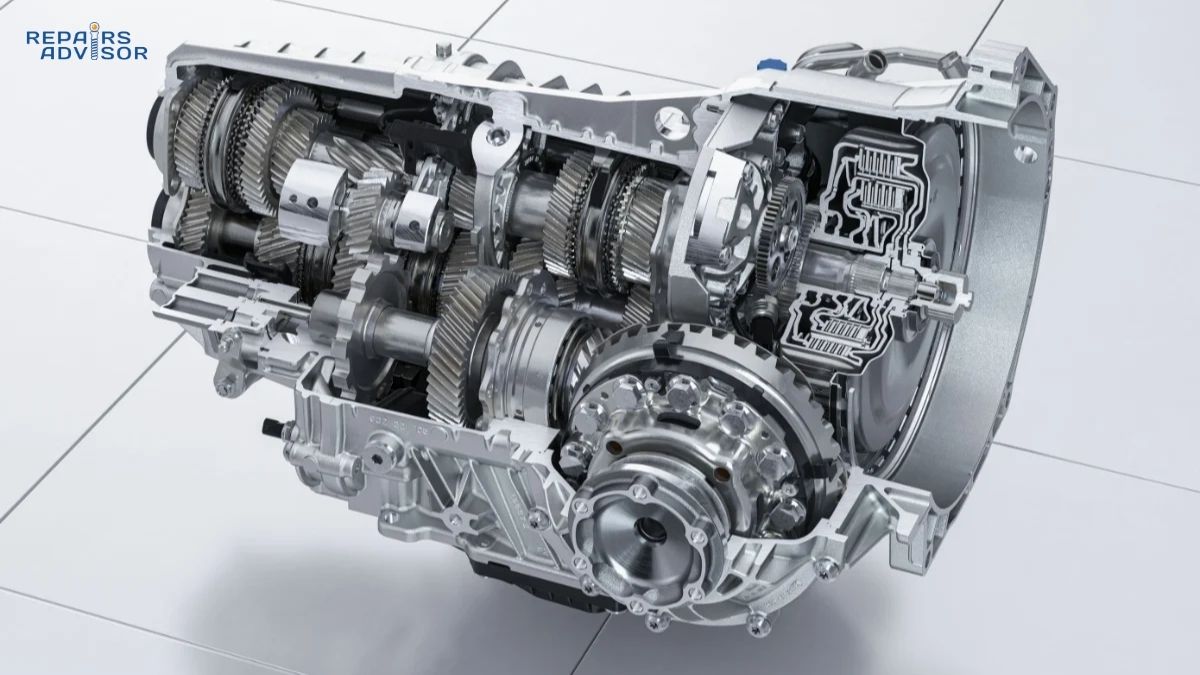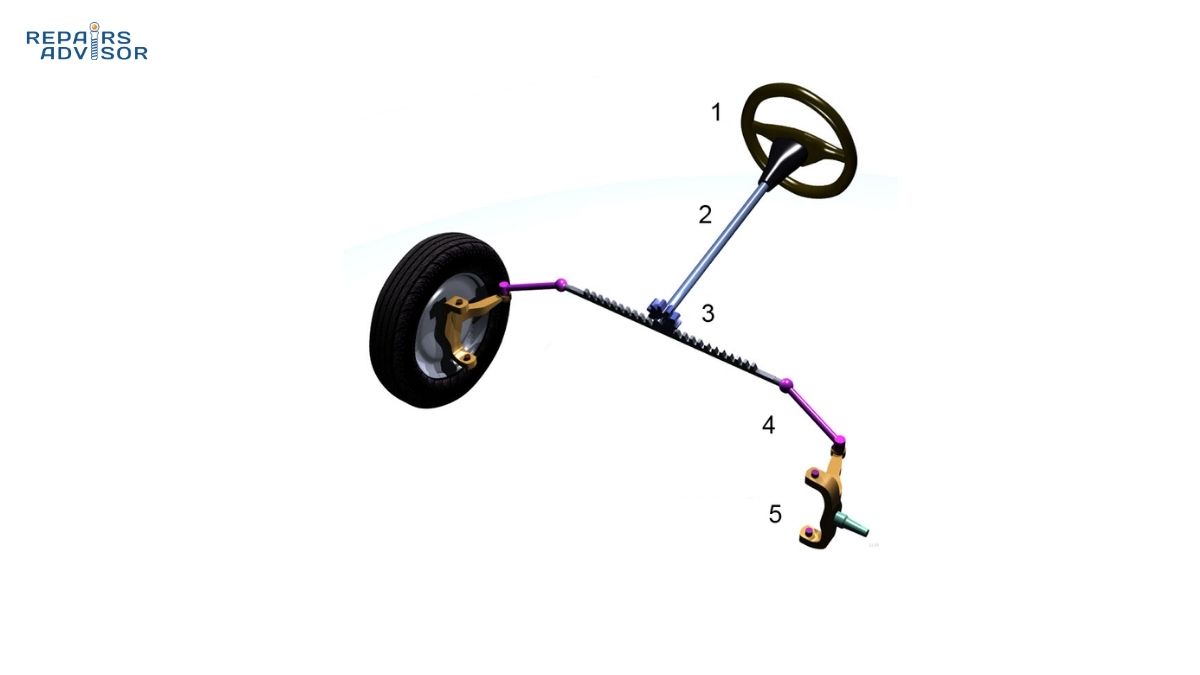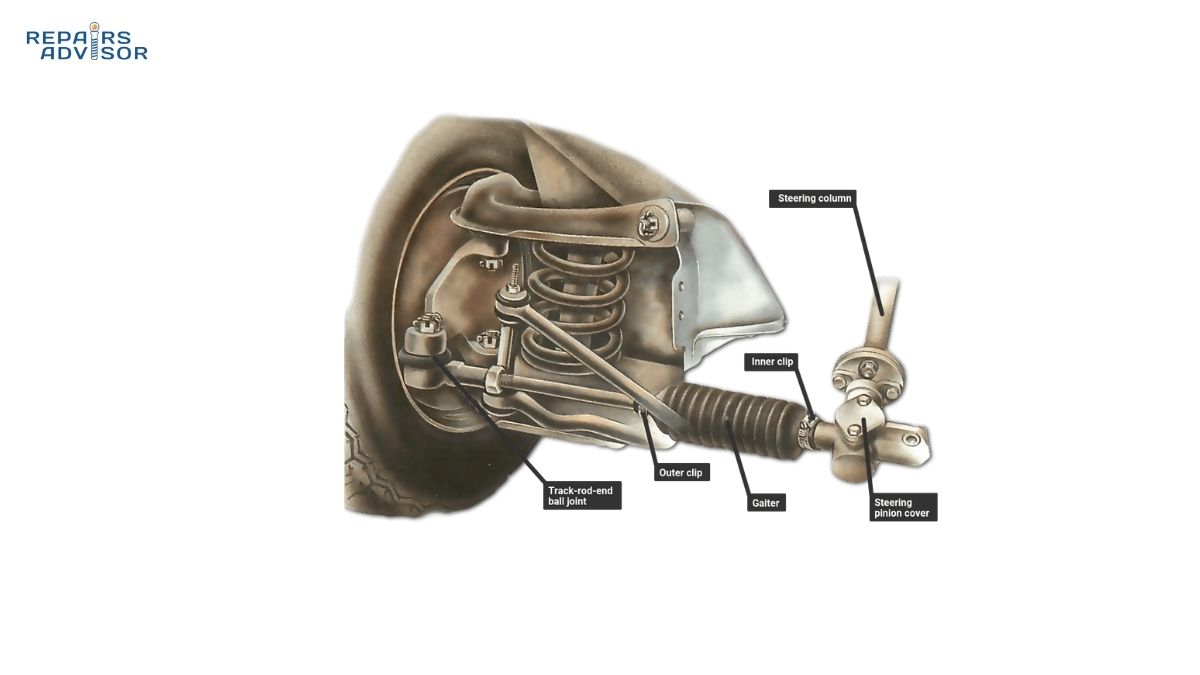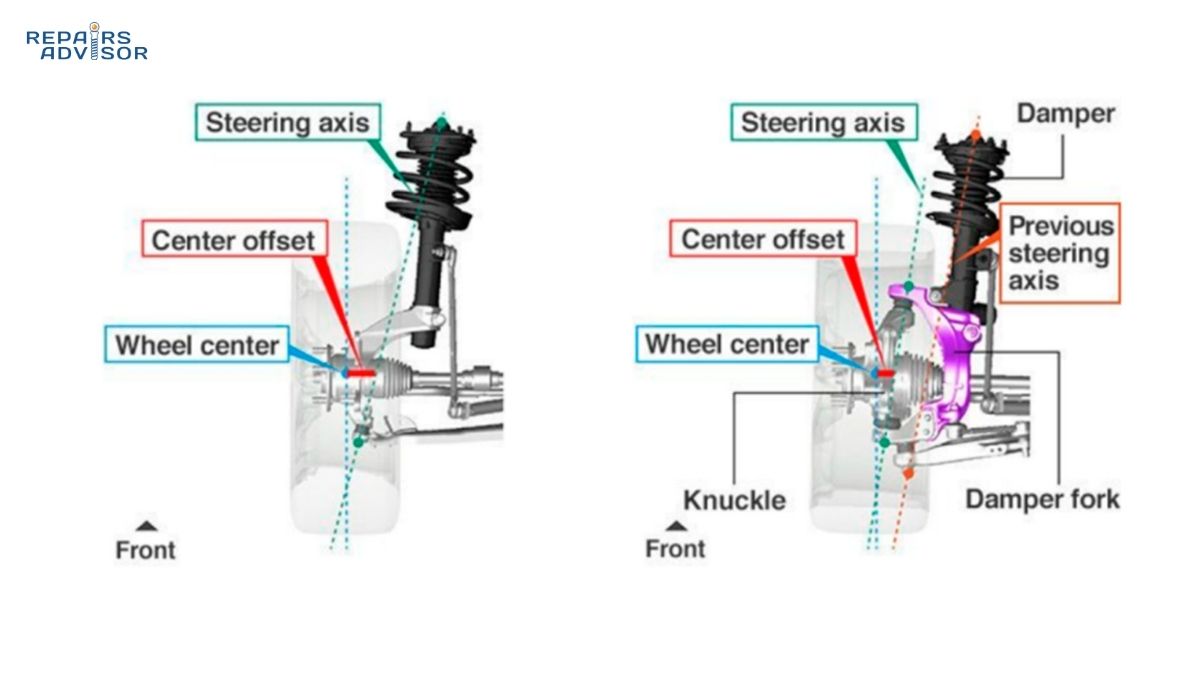If you’ve ever wondered how your automatic transmission vehicle can idle smoothly at a stoplight without stalling the engine, the answer lies in a remarkable component called the torque converter. This fluid coupling device replaces the mechanical clutch found in manual transmissions, using hydraulic pressure instead of friction plates to transfer power from your engine to the transmission. Understanding how torque converters work helps you recognize problems early, maintain your transmission properly, and appreciate the engineering that makes modern automatic transmissions possible.
The torque converter serves a dual purpose: it allows your engine to continue running while your vehicle is stopped, and it multiplies engine torque by two to three times during acceleration from a standstill. This torque multiplication gives your vehicle the extra power needed to overcome inertia and get moving smoothly. Located between the engine’s flexplate and the transmission input shaft, the torque converter operates through three distinct phases—stall, acceleration, and coupling—each optimized for different driving conditions.
Safety Note: Torque converter diagnosis requires specialized equipment, and replacement necessitates complete transmission removal. While understanding torque converter function helps with early problem detection, repair work should be performed by qualified transmission specialists. If you experience transmission shuddering, slipping, overheating, or delayed engagement, seek professional diagnosis immediately to prevent cascading transmission damage.
This guide explains torque converter construction, operation through all three phases, common failure symptoms, maintenance requirements, and when professional service becomes necessary. For comprehensive automatic transmission system information, see our guide on how automatic transmissions work.
What is a Torque Converter? Core Components Explained
A torque converter is a fluid coupling device that transfers rotating power from the engine to the automatic transmission using pressurized transmission fluid rather than a mechanical connection. Think of it as two fans facing each other—one powered by the engine blows fluid at the second fan, causing it to spin and drive the transmission. This fluid coupling allows the engine and transmission to operate at different speeds, enabling your engine to idle while the vehicle remains stationary.
The torque converter housing bolts directly to the engine’s flexplate (the automatic transmission equivalent of a flywheel), connecting it to the crankshaft. Inside this sealed housing, three main components work together to transfer power and multiply torque. Learn more about the connection between engine and transmission in our article on how flywheel and flexplate work.
The Impeller (Pump)
The impeller is mechanically connected to the torque converter housing and therefore spins at engine speed at all times. Its curved, fan-like blades function as a centrifugal pump, flinging transmission fluid outward toward the outer edge of the converter as it rotates. The faster the engine runs, the more forcefully the impeller throws fluid outward, creating a vacuum at the center that continuously draws more fluid in. This centrifugal pumping action generates the high-velocity fluid flow that powers the entire torque converter system.
The impeller design is critical to converter efficiency. The blade angles, curvature, and spacing determine how effectively the impeller can accelerate fluid and direct it toward the turbine. Performance converters often feature modified impeller blade designs to optimize fluid flow for specific applications, whether high-performance acceleration or heavy-duty towing.
The Turbine
The turbine connects directly to the transmission input shaft through a splined connection, making it the component that actually drives your transmission and wheels. Positioned opposite the impeller, the turbine receives the high-velocity fluid thrown by the impeller. The turbine’s curved blades are designed to capture the kinetic energy of the moving fluid, causing the turbine to rotate. As fluid strikes the turbine blades, it transfers its momentum and forces the turbine to spin, converting hydraulic energy back into mechanical rotation.
The turbine blades feature a specific curvature that optimizes energy capture while redirecting fluid flow toward the center of the converter. Unlike the impeller, which always rotates at engine speed, the turbine speed varies based on vehicle speed and load conditions. This speed differential between impeller and turbine is what enables torque multiplication—when the impeller spins much faster than the turbine, the converter multiplies torque to provide extra power for acceleration.
The Stator
The stator resides in the very center of the torque converter, between the impeller and turbine. Its job is to redirect fluid returning from the turbine before it re-enters the impeller, dramatically increasing converter efficiency and enabling torque multiplication. Without the stator, fluid exiting the turbine would flow in the opposite direction to impeller rotation, actually working against the engine and wasting power.
The stator features aggressive blade angles that reverse fluid direction by nearly 90 degrees. This redirected fluid re-enters the impeller in the same direction it’s already rotating, effectively “assisting” the impeller and multiplying the torque being transmitted. The stator mounts on a one-way clutch that prevents it from rotating backward (counter to engine rotation) but allows it to freewheel forward once the vehicle reaches cruising speed and the fluid flow direction changes.
Additional Essential Components
Modern torque converters include a lockup clutch—an electronically controlled friction clutch that can mechanically lock the turbine directly to the impeller at highway speeds. When engaged, the lockup clutch eliminates all slippage between engine and transmission, improving fuel economy by 5-15 percent during sustained cruising. The clutch disengages during acceleration, deceleration, and gear changes to allow the fluid coupling benefits when needed.
The entire assembly relies on clean, properly specified automatic transmission fluid (ATF) as the medium for power transfer. The fluid must maintain specific viscosity across a wide temperature range while resisting thermal breakdown. Degraded or contaminated fluid reduces converter efficiency and accelerates internal component wear. For detailed information about transmission fluid properties, see our guide on how ATF and friction materials work.
How Torque Converters Work: Three Operating Phases
Torque converters operate through three distinct phases depending on the speed relationship between the impeller and turbine. Understanding these phases explains how your transmission can provide smooth power delivery from a standstill through highway cruising.
Phase 1: Stall Phase
The stall phase occurs when your engine is running, the transmission is in gear, and your foot holds the brake pedal, preventing the vehicle from moving. During this phase, the impeller spins at engine idle speed (typically 600-900 RPM), throwing fluid against the turbine blades. However, because you’re holding the brake and the vehicle load prevents the wheels from turning, the turbine cannot rotate despite receiving fluid pressure from the impeller.
This condition creates maximum torque multiplication—the converter can multiply engine torque by two to three times during the stall phase. The stator’s role is critical here: it redirects the fluid from the stationary turbine back into the impeller in the direction of rotation, adding energy to the system rather than fighting against it. This is why your engine doesn’t stall when stopped in gear—the fluid coupling allows slippage while still transferring enough torque to keep the engine loaded appropriately.
Every torque converter has a specific stall speed—the maximum RPM the engine can reach against a stationary turbine before the turbine begins to overcome the load and rotate. Typical stall speeds range from 1,800 to 2,500 RPM for passenger vehicles. Performance vehicles may use high-stall converters (2,500-3,500 RPM) that allow the engine to reach its power band before the vehicle begins moving, improving acceleration. Heavy-duty applications like towing benefit from lower stall speeds that provide maximum torque at lower RPMs.
Important Testing Note: You can roughly estimate your converter’s stall speed by placing the transmission in Drive, firmly applying the brake, and briefly pressing the accelerator while observing the tachometer. However, this “brake stall test” should only be performed for 2-3 seconds maximum to prevent converter and transmission overheating. Extended stall testing can damage transmission clutches and cause severe heat buildup. For accurate stall speed testing, professional technicians use dynamometers with proper vehicle restraints.
Phase 2: Acceleration Phase
When you release the brake and press the accelerator, the vehicle enters the acceleration phase. During this phase, significant speed difference exists between the impeller (spinning at increasing engine RPM) and the turbine (spinning at lower speed proportional to vehicle speed). This speed differential is where torque multiplication occurs—the greater the difference between impeller and turbine speed, the more torque multiplication the converter provides.
As the engine RPM increases with throttle application, the impeller flings fluid with increasing velocity and force. This high-energy fluid strikes the turbine blades with considerable momentum, creating torque. The stator continues redirecting returning fluid to assist the impeller, maintaining the multiplication effect. Peak torque multiplication occurs just as the vehicle begins moving from a standstill, when the impeller might be spinning at 2,000 RPM while the turbine is barely rotating.
As vehicle speed increases and the turbine speeds up, the multiplication factor gradually decreases. For example, when the impeller reaches 2,000 RPM and the turbine is spinning at 1,000 RPM, the converter might provide approximately 2:1 torque multiplication. When the turbine accelerates to 1,500 RPM, the multiplication drops closer to 1.5:1. This progressive reduction in multiplication provides smooth, seamless power delivery as the vehicle gains speed.
During acceleration, some energy is inevitably lost to heat as the fluid is compressed and sheared between the rotating components. This represents a 5-10 percent efficiency loss compared to a mechanical clutch connection. However, the benefits of smooth power delivery, no manual shifting, and protection of the transmission from engine power spikes typically outweigh this minor efficiency penalty. Modern transmission designs minimize these losses through optimized blade geometry and electronic lockup clutch control.
Phase 3: Coupling Phase
The coupling phase begins when the turbine speed reaches approximately 90 percent of impeller speed, typically occurring during highway cruising. At this point, the speed differential becomes so small that torque multiplication essentially ceases, and the converter operates at approximately 1:1 ratio—engine torque passes through to the transmission without multiplication.
The fluid flow dynamics change dramatically during coupling. With minimal speed difference between impeller and turbine, the fluid no longer needs significant redirection from the stator. In fact, the fluid begins flowing in the opposite direction, attempting to push the stator in the same direction as the impeller and turbine. This is where the one-way clutch becomes important—it releases, allowing the stator to freewheel forward. Now all three components (impeller, turbine, and stator) rotate together as essentially a single unit.
During the coupling phase, modern torque converters typically engage the lockup clutch. This electronically controlled clutch mechanically locks the turbine directly to the impeller, eliminating all fluid coupling and slippage. The lockup clutch engagement provides several benefits: fuel economy improves 5-15 percent by eliminating converter slip losses, transmission operating temperature decreases because less heat is generated, and drivetrain response becomes more direct.
The transmission control module monitors vehicle speed, engine load, throttle position, and transmission temperature to determine optimal lockup clutch engagement timing. The lockup clutch disengages during deceleration, gear changes, and heavy acceleration to restore the fluid coupling benefits. Some modern transmissions use variable lockup clutch application, allowing partial engagement for even better efficiency while maintaining some cushioning effect. Learn more about electronic transmission control in our article on how automatic transmission mechatronics work.
Common Torque Converter Problems and Failure Symptoms
Torque converter problems manifest through several distinctive symptoms that differ from typical transmission issues. Recognizing these symptoms early allows you to seek professional diagnosis before minor problems escalate into complete transmission failure.
Shuddering During Acceleration
One of the most common torque converter problems is a shuddering or vibration that feels like driving over a rumble strip or cattle grid. This shuddering typically occurs at specific speeds, most commonly between 30-50 MPH during light to moderate acceleration. The vibration may disappear if you accelerate harder or coast, making it seem intermittent.
Converter shudder usually results from a failing lockup clutch, contaminated transmission fluid, or worn internal bearings in the stator assembly. The lockup clutch friction material can become glazed or develop hot spots, causing it to grab and release rapidly rather than engaging smoothly. Contaminated fluid can cause the clutch material to slip excessively, leading to heat buildup and shuddering. Some vehicles are more prone to this condition than others—certain Toyota, Honda, and GM models from the 2010s have well-documented torque converter shudder issues.
Addressing shuddering early is critical. Left unchecked, the excessive heat and vibration can damage transmission clutch packs, wearing out the entire transmission and turning a converter replacement into a full transmission rebuild. If you experience persistent shuddering, have your transmission fluid inspected and changed if contaminated, and have a transmission specialist perform stall speed and pressure tests to confirm converter condition.
Slipping or Delayed Engagement
When your torque converter begins failing, you may notice delayed engagement when shifting from Park or Neutral into Drive or Reverse. A properly functioning torque converter should engage almost immediately—within one second at most. If you experience a delay of two or more seconds before the vehicle begins moving, or if the engagement is accompanied by a harsh clunk, the converter may be failing.
Slipping manifests as the engine RPM increasing without a corresponding increase in vehicle speed. You press the accelerator, the engine revs climb, but the vehicle doesn’t accelerate proportionally. This indicates the turbine isn’t receiving adequate power from the impeller, either due to extremely low fluid level, worn friction materials in the lockup clutch, or damaged turbine blades that can’t effectively capture fluid energy.
Several conditions can cause these symptoms. Low transmission fluid level—often from a converter seal leak—prevents adequate hydraulic pressure buildup. Worn lockup clutch friction material causes excessive slippage when the clutch tries to engage. Bent or damaged turbine blades, possibly from metal contamination in the transmission fluid, reduce the turbine’s ability to capture fluid momentum. In severe cases, complete internal converter failure can prevent power transfer entirely.
Transmission Overheating
The torque converter can be a significant heat source when malfunctioning. Normal converter operation generates some heat through fluid friction and compression, but a failing converter generates excessive heat that overwhelms the transmission cooling system. Your dashboard may display a transmission temperature warning light, or you might notice a burnt, sweet-smelling odor from the transmission fluid.
Excessive slippage is the primary cause of converter-related overheating. When the lockup clutch fails to engage properly or when internal damage prevents efficient power transfer, the resulting slippage converts kinetic energy directly into heat. Temperatures can quickly exceed 260°F—well above the normal operating range of 175-220°F. At these temperatures, transmission fluid breaks down rapidly, destroying its lubricating and hydraulic properties and creating a cascading failure scenario.
Overheating particularly affects vehicles used for towing or those frequently operating in stop-and-go traffic where the converter works harder. If your transmission regularly runs hot, verify that the transmission cooler (usually integrated into the radiator) is functioning properly and consider installing an auxiliary transmission cooler. Persistent overheating requires professional diagnosis—continuing to drive with an overheating transmission can cause complete transmission failure within days or even hours.
Unusual Noises
A failing torque converter can produce several distinctive noises that differ from typical transmission sounds. You might hear a whining noise that increases with engine RPM, similar to a power steering pump noise but coming from the transmission area. This whining typically indicates worn needle bearings in the stator assembly or damaged bearing surfaces in the converter housing.
Grinding or rattling noises, especially at idle when the transmission is in Drive, suggest the stator one-way clutch has failed. The clutch may be stuck partially engaged, causing the stator to chatter as it tries to freewheel, or it may have completely broken, allowing loose components to rattle inside the converter housing. Some vehicles produce a characteristic “buzzing” sound at idle in gear when the converter lockup clutch is failing—the clutch material vibrates at specific frequencies, transmitting noise through the drivetrain.
Metal-on-metal grinding sounds are particularly concerning and suggest severe internal damage. Catastrophic bearing failure can allow components to contact each other directly, generating metal debris that contaminates the entire transmission. If you hear grinding noises from the transmission area, stop driving immediately and have the vehicle towed to a transmission shop. Continued operation can transform a converter replacement into a complete transmission rebuild.
Contaminated Transmission Fluid
While not a symptom you’ll notice while driving, contaminated transmission fluid discovered during routine maintenance is a critical warning sign. Normal automatic transmission fluid is bright red or pink and has a slightly sweet petroleum smell. As it ages, it darkens to brown but should remain relatively transparent. If your transmission fluid is dark brown or black, has a burnt acrid odor, or contains visible metal particles, internal transmission or converter damage has occurred.
The torque converter can both cause and be victimized by fluid contamination. A failing converter generates metal debris from worn bearings, damaged stator blades, or disintegrating friction material. This debris circulates through the entire transmission, accelerating wear on every component. Conversely, a failed transmission component can contaminate the fluid with metal particles that then enter the converter, damaging its internal components and causing converter failure.
Critical Warning: A failing torque converter can rapidly destroy a healthy transmission through metal contamination. If you experience any symptoms of converter failure—shuddering, slipping, overheating, or unusual noises—seek professional diagnosis immediately. Catching converter problems early often means replacing only the converter rather than rebuilding the entire transmission. For related transmission system information, see our guide on how planetary gearsets and valve bodies work.
Torque Converter Maintenance and Fluid Requirements
While the torque converter itself is a sealed unit with no serviceable internal parts, proper maintenance of your automatic transmission system directly affects converter longevity and performance. Following manufacturer maintenance schedules and using correct fluid specifications can extend converter life by tens of thousands of miles.
Regular Transmission Fluid Changes
The single most important maintenance task for torque converter longevity is regular transmission fluid changes. Despite some manufacturers claiming “lifetime” transmission fluid, the reality is that ATF degrades over time and with use. Heat, friction, and contamination gradually destroy the fluid’s lubricating properties, hydraulic characteristics, and thermal stability.
Most transmission specialists recommend changing automatic transmission fluid every 30,000-60,000 miles depending on driving conditions. Severe service—towing, frequent stop-and-go traffic, dusty conditions, or extreme temperatures—requires more frequent changes at the lower end of this range. Normal highway driving allows extending the interval toward the upper end. Consult your owner’s manual for manufacturer-specific recommendations, but understand that “lifetime fill” claims are often marketing language rather than sound engineering advice.
When changing transmission fluid, a simple drain-and-fill typically replaces only 30-50 percent of the total fluid since 4-6 quarts remain in the torque converter and cannot drain by gravity. A complete transmission flush uses specialized equipment to exchange all fluid, including what’s in the converter. However, some transmission specialists caution against high-pressure flushing on high-mileage transmissions, arguing that dislodging accumulated deposits can cause more problems than it solves. Consult a trusted transmission shop for the best approach for your specific vehicle and mileage.
Using Correct Fluid Specification
Automatic transmission fluid isn’t universal—different transmissions require specific fluid types, and using incorrect fluid can cause immediate problems or accelerate wear. Modern transmissions use highly specialized fluids engineered for specific frictional characteristics, thermal properties, and hydraulic performance. The wrong fluid can cause harsh shifting, reduced fuel economy, overheating, and premature converter failure.
Common ATF specifications include Dexron VI (General Motors), Mercon V and LV (Ford), ATF+4 (Chrysler), and various manufacturer-specific formulations like Honda DW-1, Toyota WS, or Nissan Matic fluids. Some continuously variable transmissions (CVT) require completely different fluid that would destroy a conventional automatic transmission if used incorrectly. Always verify the correct fluid specification in your owner’s manual or consult a dealership parts department before adding or changing transmission fluid.
Synthetic ATF offers several advantages over conventional petroleum-based fluid, including better thermal stability, improved low-temperature fluidity, longer service life, and enhanced oxidation resistance. Many modern vehicles come factory-filled with synthetic ATF. While synthetic fluid costs more—sometimes $12-18 per quart versus $6-8 for conventional—the extended service intervals and better protection often justify the premium. Some performance and heavy-duty applications specifically require synthetic fluid for adequate protection under extreme operating conditions. For comprehensive information about transmission fluid chemistry and performance, see our detailed guide on how ATF and friction materials work.
Transmission Cooler Importance
The transmission cooler plays a critical role in torque converter longevity by managing the heat generated during normal operation. Most vehicles integrate the transmission cooler into the engine radiator as a separate section through which transmission fluid flows. In this setup, engine coolant actually cools the transmission fluid through the heat exchanger walls. Some vehicles, particularly trucks and SUVs with towing packages, include additional external transmission coolers for enhanced cooling capacity.
Verify that your transmission cooling system functions properly during routine maintenance. A restricted transmission cooler can cause fluid temperatures to climb 40-60°F above normal, dramatically accelerating fluid breakdown and component wear. If your vehicle is frequently used for towing, operates in hot climates, or experiences regular transmission temperature warnings, consider installing an aftermarket auxiliary transmission cooler. These coolers typically mount in front of the radiator and can reduce transmission operating temperatures by 20-40°F, significantly extending both converter and transmission life.
Transmission cooler failure can occur in two ways, both problematic. If the cooling passages become clogged with debris or scale, fluid cannot circulate properly and temperatures soar. More insidiously, if the heat exchanger walls fail in an integrated radiator cooler, engine coolant and transmission fluid can intermix. This creates a strawberry milkshake-looking substance in both systems and causes catastrophic transmission and converter damage within miles. If you notice pink fluid in your coolant reservoir or white/pink foam on the transmission dipstick, stop driving immediately and have the vehicle towed for service.
Torque Converter Replacement Considerations
Unlike some transmission components that can be rebuilt or repaired, torque converters are typically replaced as complete units when they fail. The welded housing construction and precisely balanced internal components make rebuild attempts impractical for most shops. When replacement becomes necessary, expect significant costs due to the labor-intensive nature of the job—the transmission must be completely removed from the vehicle to access the converter.
Typical torque converter replacement costs break down as follows: the converter itself ranges from $200-600 depending on vehicle type and quality level (OEM versus aftermarket), with performance and heavy-duty converters costing up to $1,000 or more. Labor adds $400-1,000 depending on vehicle configuration and shop rates, with the job typically requiring 4-10 hours. Front-wheel-drive vehicles with transverse-mounted engines generally take longer due to limited access. Total replacement costs typically range from $700 to $2,500 for most passenger vehicles.
Critical Installation Requirement: Whenever replacing a torque converter, always perform a complete transmission fluid flush and replace the transmission filter. The failed converter has contaminated the fluid with metal debris and friction material particles. Installing a new converter without thoroughly cleaning the transmission and cooler lines guarantees premature failure of the new converter. Many transmission shops will refuse to warranty converter replacement if proper cleaning isn’t performed. Some technicians also recommend flushing the transmission cooler separately with solvent to ensure all contamination is removed before installing the new converter.
Performance and Heavy-Duty Converter Options
While most drivers need only a stock-specification replacement converter, performance and heavy-duty applications benefit from upgraded converters designed for specific use cases. High-stall converters (2,500-3,500 RPM stall speed) allow performance engines to reach their power band before the vehicle moves, improving acceleration at the expense of low-speed drivability and fuel economy. These converters are popular in drag racing and performance street applications with modified engines producing peak power at higher RPM.
Conversely, towing-oriented converters feature lower stall speeds and more aggressive lockup clutch designs to keep the converter locked a higher percentage of the time. This reduces heat generation during sustained highway towing and improves fuel economy while pulling heavy loads. Heavy-duty converters also typically feature beefier internal components—larger bearings, thicker fins, and upgraded friction materials—to withstand the increased stress of towing applications.
When selecting an upgraded converter, matching the stall speed to your engine’s torque characteristics and intended use is critical. A converter with too high a stall speed won’t provide adequate low-speed torque multiplication and will generate excessive heat during normal driving. Too low a stall speed prevents a modified engine from reaching its power band, negating performance gains. Consult with a transmission specialist or performance shop familiar with your specific vehicle and modifications to select the optimal converter specification.
Where is the Torque Converter Located and How to Access It
The torque converter occupies a specific location in the powertrain assembly, positioned between the engine and transmission. Understanding its location helps diagnose problems and recognize the complexity of accessing it for service.
Physical Location and Mounting
The torque converter bolts directly to the engine’s flexplate, which in turn bolts to the crankshaft. In automatic transmission vehicles, the flexplate serves the same function as the flywheel in manual transmission applications—it provides a mounting surface for the starter ring gear and connects the engine to the drivetrain. The flexplate is a relatively thin stamped steel disc compared to the much heavier cast iron flywheel used with manual transmissions. For comparison between these components, see our guide on how flywheel and flexplate work.
The converter housing bolts to the flexplate with typically three to six bolts arranged in a circular pattern. This rigid connection ensures the converter impeller rotates at exactly engine crankshaft speed. The transmission input shaft extends into the center of the converter where it splines into the turbine, creating the mechanical connection that drives the transmission. The entire assembly resides inside the transmission bell housing—the large metal housing at the front of the transmission that mates to the engine block.
Visual Identification When Transmission is Removed
When a transmission is removed from a vehicle for service, the torque converter becomes visible. It appears as a large circular housing, typically 10-14 inches in diameter depending on vehicle size and engine torque. The converter weighs 20-40 pounds when full of fluid—a significant mass that must be carefully supported during transmission removal and installation to prevent it from falling and causing injury.
The converter face features a bolt pattern where it attaches to the flexplate. At the center, you’ll see the opening where the transmission input shaft inserts into the turbine. Some converters include a drain plug that allows draining the old fluid before installation, though many modern converters are sealed without drain provisions. The converter housing typically displays identification markings or stamped numbers that indicate the part number, stall speed specification, and manufacturing date.
Why Access is Extremely Limited
Unlike many automotive components that can be inspected, tested, or serviced with the vehicle on the ground or supported on jack stands, the torque converter requires complete transmission removal for any hands-on work. This makes converter replacement one of the most labor-intensive drivetrain repairs you can face. Access limitations stem from the converter’s position—it sits inside the sealed bell housing, entirely enclosed between the engine block and transmission case.
To access the torque converter for removal, technicians must support the engine from above with an engine support fixture or from below with transmission jacks, disconnect all transmission-related components (cooler lines, wiring harnesses, shift linkage, drive shafts or axles, crossmembers, and exhaust components as needed), and lower the entire transmission assembly away from the engine. Only then does the converter become accessible. The reverse installation process requires precise alignment of the converter with both the flexplate bolt pattern and the transmission pump drive—misalignment can damage the transmission pump or prevent proper converter seating, leading to catastrophic failure.
DIY vs. Professional Service Reality
Given the access requirements, torque converter work falls firmly into the professional service category for most vehicle owners. The job requires specialized equipment including transmission jacks (rated for 500-1,000 pounds), engine support fixtures, proper jack stands or a vehicle lift, alignment tools, and torque wrenches capable of handling the 30-50 foot-pound converter bolt specifications. Beyond tools, the procedure demands specific technical knowledge about bolt sequences, torque specifications, fluid refill procedures, and post-installation air bleeding.
While intermediate DIY mechanics with proper equipment and experience can successfully remove and replace transmissions, the risk of mistakes is substantial. Improperly installed converters can damage the transmission pump drive, leak fluid from improper seal seating, or fail to seat fully against the flexplate (a condition called “converter not seated” that causes immediate transmission destruction when started). The consequences of errors often exceed the initial repair cost by thousands of dollars.
Safety Warning: Attempting torque converter replacement without proper training, equipment, and experience is extremely dangerous. The transmission assembly weighs 100-200 pounds depending on vehicle type, and improper support can result in the transmission falling and causing severe injury or death. Additionally, the torque converter itself can fall out of the transmission during removal if not properly supported, causing injury and damage. This is not an appropriate DIY repair for most home mechanics—consult professional transmission specialists for this work. For related clutch system information in manual transmissions, see our guides on how manual transmission and clutch work and how hydraulic clutch systems work.
Professional Diagnosis and Testing Procedures
Accurate torque converter diagnosis requires specialized equipment and knowledge that goes beyond visual inspection. Professional technicians use multiple diagnostic approaches to distinguish converter problems from other transmission issues that may present similar symptoms.
Electronic Diagnostics and Scan Tool Analysis
Modern diagnostic scanners provide invaluable data for torque converter diagnosis. Transmission control modules store diagnostic trouble codes (DTCs) specifically related to torque converter clutch operation, including P0740 (TCC circuit malfunction), P0741 (TCC performance), P0742 (TCC stuck on), and P0743 (TCC electrical circuit problem). While these codes indicate a problem in the converter clutch circuit, they don’t necessarily confirm converter failure—the issue could be a faulty solenoid, wiring problem, or transmission control module fault.
Beyond codes, scan tools allow technicians to monitor real-time transmission data including input and output shaft speeds, transmission fluid temperature, torque converter clutch commanded status (on/off), and calculated slip rates. By comparing input shaft speed (which reflects engine RPM after the torque converter) to output shaft speed (which reflects vehicle speed), technicians can calculate how much slippage occurs across the converter. Excessive slip during the coupling phase indicates converter problems. Normal slip during acceleration is expected, but slip should drop to near zero when the lockup clutch engages at cruising speed.
Transmission fluid temperature monitoring reveals important diagnostic information. If fluid temperature climbs above 220°F during normal driving, excessive converter slippage or other internal transmission problems may be generating heat. Some scan tools can command the transmission control module to engage and disengage the torque converter lockup clutch, allowing technicians to verify whether the clutch responds correctly and whether engagement eliminates slippage as expected.
Hydraulic Pressure Testing
Transmission pressure testing provides direct measurement of the hydraulic pressures that control converter operation. Professional transmission shops have specialized pressure test kits with gauges and fittings designed to connect to transmission test ports. By monitoring line pressure and converter clutch circuit pressure during operation, technicians can identify whether hydraulic problems exist within the transmission or converter.
The torque converter lockup clutch requires adequate hydraulic pressure to engage—typically 60-100 PSI depending on vehicle specifications. If pressure to the clutch circuit is low, the clutch cannot fully engage, causing slippage and overheating. Low pressure can result from internal transmission wear, a faulty torque converter clutch solenoid, or external leaks. Normal line pressure but abnormal clutch circuit behavior suggests a problem within the converter itself—either a failed seal, damaged clutch friction material, or mechanical damage preventing proper engagement.
Pressure testing during stall conditions provides additional diagnostic value. While in Park, line pressure should be within specifications. Shifting to Drive and loading the engine slightly (not full stall testing) should cause pressure to rise as the transmission control module commands increased pressure for torque converter loading. Pressure that doesn’t respond appropriately to load changes indicates control system problems that may affect converter operation.
Stall Speed Testing Procedure
Stall speed testing measures the maximum engine RPM that can be achieved when the transmission is in gear but the turbine is prevented from rotating. This test provides direct insight into torque converter condition and can identify specific types of failures. However, stall speed testing must be performed carefully by trained technicians—extended testing can cause severe transmission overheating and damage.
Professional stall speed testing ideally occurs on a dynamometer where the vehicle can be properly restrained and operated under controlled conditions. If performed without a dyno, the vehicle must be on level ground with the parking brake firmly applied and wheels chocked to prevent movement. The test procedure involves placing the transmission in Drive, firmly applying the service brake, and briefly (2-3 seconds maximum) applying full throttle while observing the tachometer.
Comparing the measured stall speed to manufacturer specifications reveals converter condition. Stall speed higher than specification (by 200+ RPM) typically indicates slipping transmission clutches rather than converter problems—the engine can rev higher because the transmission cannot hold the load. Stall speed lower than specification suggests insufficient engine power, a problem with torque converter design, or a stator one-way clutch that has seized in the locked position, preventing proper torque multiplication.
Important Testing Safety Note: Stall speed testing generates tremendous heat extremely quickly. Never perform stall testing for more than 3 seconds at a time, and allow at least 2-3 minutes of cooling between tests. Extended stall testing can raise transmission fluid temperature by 100°F or more in seconds, causing immediate clutch damage and fluid breakdown. Never perform stall testing if the transmission is already hot or if fluid levels are low.
When Professional Diagnosis Becomes Essential
Several situations mandate professional transmission diagnosis rather than attempting DIY troubleshooting. If your check engine light illuminates with transmission-related codes, the diagnostic sophistication required to distinguish between converter problems, transmission faults, and control system issues exceeds typical DIY capabilities. Similarly, intermittent problems that come and go require systematic data logging and analysis that only professional-grade scan tools provide.
Any symptoms that affect vehicle safety—complete loss of Drive or Reverse, sudden transmission overheating, or severe vibrations that worsen with speed—require immediate professional attention. These conditions can indicate imminent transmission failure, and continued driving risks complete breakdown or safety hazards. Burnt transmission fluid smell, visible leaks, or slipping under load all warrant professional diagnosis before problems escalate to more expensive repairs.
Choose transmission specialists carefully—general repair shops may lack the specific expertise and equipment for proper converter diagnosis. Look for shops that specialize in transmission repair, have ASE-certified transmission technicians on staff, and can provide warranties on their diagnostic conclusions and repair work. Proper diagnosis may cost $100-200, but this investment prevents unnecessary transmission removal or misdiagnosed problems that lead to repeated repairs. For additional diagnostic resources, explore our section on diagnostics and troubleshooting.
Conclusion: The Critical Role of Torque Converters in Automatic Transmissions
The torque converter represents one of automotive engineering’s most elegant solutions to power transfer challenges. By using hydraulic fluid coupling instead of mechanical friction, it enables automatic transmissions to provide seamless power delivery from standstill through highway cruising while protecting drivetrain components from shock loads. The three-phase operation—stall, acceleration, and coupling—optimizes power transfer for different driving conditions, with the stator’s fluid redirection providing crucial torque multiplication when needed most.
Understanding torque converter function helps you recognize problems early through symptoms like shuddering, slipping, overheating, or unusual noises. Regular transmission fluid maintenance remains the most important preventive measure, with changes every 30,000-60,000 miles using manufacturer-specified fluid protecting both the converter and the entire transmission. Monitoring transmission temperature, especially during towing or heavy loads, prevents the accelerated wear that high temperatures cause.
The complexity of torque converter diagnosis and replacement underscores why professional service is essential for these components. The sealed construction, location inside the bell housing, and need for complete transmission removal place converter work firmly in the professional service category. While you can certainly inspect your transmission fluid condition and monitor for symptoms, actual converter testing requires scan tools capable of monitoring transmission data, pressure testing equipment, and the expertise to interpret results correctly.
If you experience any symptoms suggesting torque converter problems—shuddering during acceleration, delayed or harsh engagement when shifting into gear, transmission overheating, or unusual whining or grinding noises—seek professional diagnosis immediately. A failing converter can quickly contaminate your transmission with metal debris, transforming a $1,500 converter replacement into a $3,500-5,000 transmission rebuild. Early detection and proper diagnosis save significant money and prevent being stranded with a non-functional vehicle.
Final Professional Service Recommendation: Torque converter replacement requires transmission removal, proper converter seating verification, precision torque specifications, and complete transmission fluid system cleaning. This is not appropriate DIY work for most vehicle owners. Consult qualified transmission specialists with proper equipment, training, and warranty coverage for converter diagnosis and replacement. Your transmission—and your wallet—will thank you for choosing professional service over attempting this complex repair at home.
For additional support or to access professional repair manuals for your specific vehicle, visit our contact page or browse our extensive collection of manufacturer-specific repair manuals.
